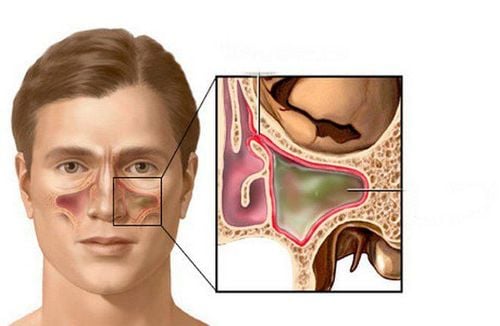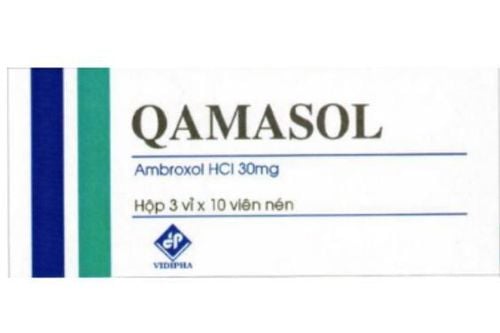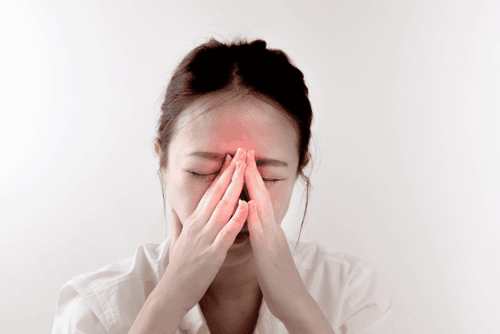This is an automatically translated article.
The article was consulted with Specialist Doctor II Nguyen Van Thai - Ear - Nose - Throat Doctor - Department of Otolaryngology and Head and Neck Surgery - Vinmec Danang International Hospital.X-ray of rhinosinusitis plays an important role in the diagnosis of diseases of the nose and sinuses. From there, the doctor can provide a quick and effective treatment, with the necessary preoperative assessment if necessary.
1. What is rhinosinusitis?
The sinuses are composed of many holes with holes in each other, located in the skull. In the sinus cavity, there is a respiratory mucosa and will secrete mucus into the nasal cavity through the openings.The nasal cavity consists of 2 main areas:
Anterior sinus area: A group of respiratory sinuses connected to the nasal cavity. Includes anterior ethmoid sinus, maxillary sinus and periorbital frontal sinus. The anterior sinus area has many diseases such as maxillary sinusitis, complications of infection to the molars and eyes. Posterior sinus area: Is the closed sinus area, including the sphenoid sinus, the posterior ethmoid sinus located below the base of the skull. Rhinitis is a fairly common disease, this is an inflammation of the respiratory mucosa lining the paranasal sinuses leading to edema, increased mucus secretion in the lining of the sinuses due to sinus congestion. Inflammation of the nose and sinuses in a short time and the disease is gone in less than 4 weeks is called acute sinusitis. Cases lasting more than 3 months are called chronic sinusitis. The main causes of sinusitis are:
Viral and bacterial infections damage hair cells in the lining of the sinuses, causing acute rhinosinusitis. Allergic factors such as cold weather, pollen, smoky environment... make sensitive sites susceptible to recurrent sinusitis Anatomical abnormalities such as nasal septum deviation, nasal polyps, hypertrophy Rolling the nose leads to poor circulation of the nose and sinuses, causing sinusitis. Symptoms of sinusitis include:
Sneezing, runny nose Then often appear stuffy and runny nose, the secretions in the nasal discharge can be clear or yellow-green. In people with severe sinusitis, there may be fever, cough, heaviness in the face, headache in the forehead, temples or cheekbones, reduced ability to perceive odors, or even no sense of smell.

2. Why should you take X-rays of your nose and sinuses when you have inflammation?
When having sinusitis, X-ray of the nose and sinuses is usually prescribed by a specialist. Through imaging, the doctor will observe the inflammation in the cavities, the degree of inflammation, has it spread to the sinuses or the surrounding area? From there, providing quick and effective treatment, limiting unnecessary surgery.However, many people are still concerned that X-rays of the nose and sinuses can affect their health. But like X-rays of other organs, the X-ray radiation used to pass through the body is very small, within the permissible limits, so it will have little or no big impact on health.
In the case of pregnant women and young children, they will be considered to choose safer imaging methods, or have safety measures. But that's not why you abuse X-rays too many times in a short time. Instead, you can bring your most recent X-ray film for your doctor to review.
3. X-ray positions of the nose and sinuses
3.1. X-ray Blondeau Sinusitis The role of the Blondeau X-ray method is to help doctors diagnose diseases of the frontal sinuses, maxillary sinuses and nasal cavities. Because when in this position, the rays shine from the back to the front. With this position, the patient needs to lie on his stomach, mouth wide open, nose and chin touching the film. If you have sinusitis, X-ray images will show:Loss of nasal cavity or narrowing due to tumor, overgrown nose. If the sinus mucosa is swollen, edematous or there is purulent fluid in the sinus cavity, mucosal degeneration, the maxillary and frontal sinuses are blurred on the film. If the bone wall is not clearly visible, further diagnosis should be made for malignancy. If the sinuses are normal, the X-ray image shows that the nasal cavity has a clear space of the slit, the orbits and bone walls, the frontal sinuses, and the jaw are evenly lit. If a foreign body is suspected, radiographs of lateral cranial sinusitis should be performed to clearly visualize the location and size of the foreign body. If sinusitis has a tumor or polyp, a contrast medium is needed to get a clearer X-ray. 3.2. X-ray Hirtz Sinusitis X-ray method of Hirtz sinusitis helps diagnose sphenoid sinusitis, anterior and posterior ethmoid sinusitis. In this position, the patient should lie on his or her back, with the head resting on top of the film. X-ray from top to bottom, giving the captured image. Specifically, the image is taken as follows:
If there is polyp or melanoma, on the image will not see or see the septum is blurred. The mucosa is thickened, inflamed pus or polyps are recorded, the sieving cells are opaque. Thus, the X-ray of the nose and sinuses plays an important role in diagnosing sinusitis, sinus tumors,... From there, the doctor can soon give a quick and effective treatment, limiting surgery. technique when not needed.

Vinmec International General Hospital with a system of modern facilities, medical equipment and a team of experts and doctors with many years of experience. Patients can rest assured that they are examined and treated at the Hospital.
Please dial HOTLINE for more information or register for an appointment HERE. Download MyVinmec app to make appointments faster and to manage your bookings easily.














